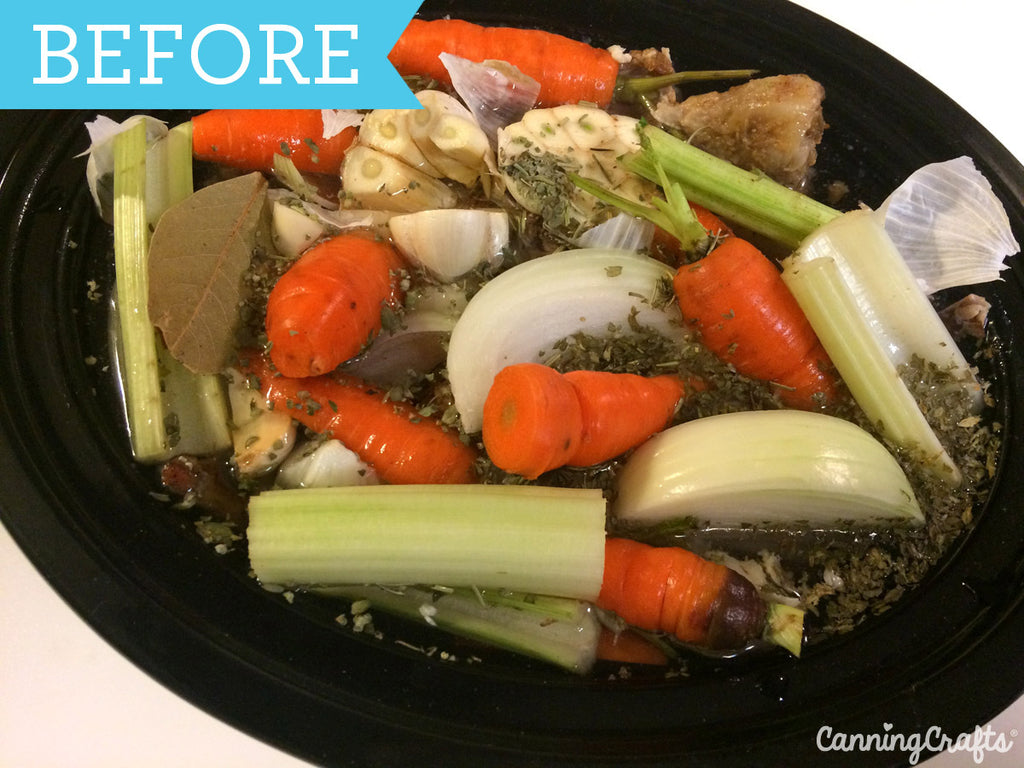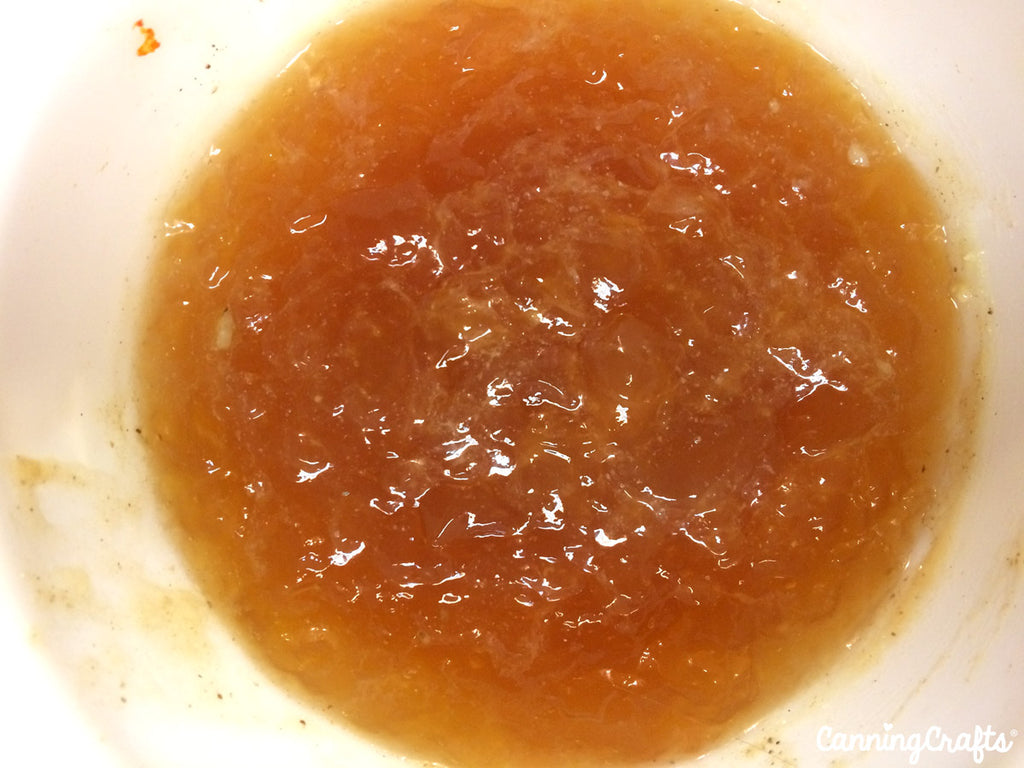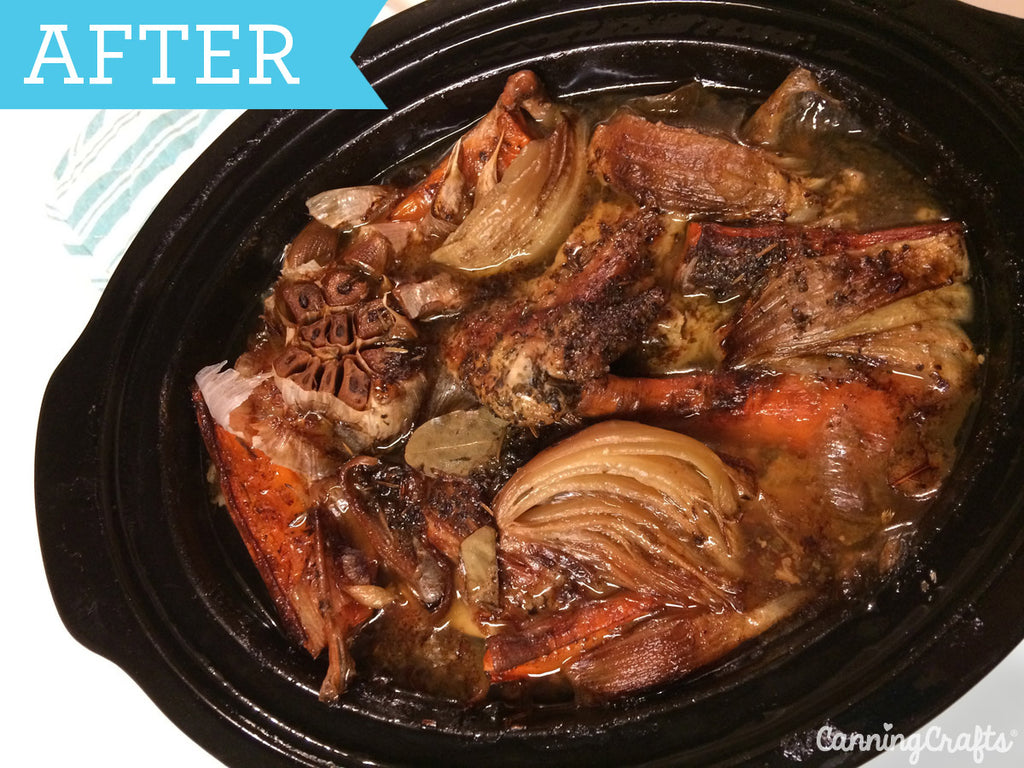How to Make Chicken Bone Broth in a Slow Cooker
06. March 2018

The Health Benefits of Bone Broth
Bone broth is truly a “super food”. You can call it "Liquid Gold" if you wish, I do! Bone broth is made from animal parts that are normally discarded: bones, marrow, cartilage, feet, etc. But it may be surprising to some to learn that those parts are loaded with nutritional value. Marrow contains lots of minerals and dense amounts of protein. Cooking bones for longer periods of time (24-36 hours) will result in more minerals in the broth. There’s also a study showing that bone marrow fat helps with insulin sensitivity and breaking down fat. It’s also linked to a decreased risk of cardiovascular disease, diabetes, and obesity-associated cancers.
Cartilage contains glucosamine and chondroitin which are common supplements for arthritic pain. It breaks down to form collagen and gelatin which are also wonderfully healthy for you. Gelatin helps reduce joint pain and bone loss. It is chock full of amino acids such as proline, glycine, and glutamine. There’s a reason traditional Jewish chicken soup is called Jewish Penicillin! The amino acids reduce inflammation in the respiratory system, strengthen immunity, and combat the common cold. They help improve digestion and reduce inflammatory gut conditions like celiac’s and ulcers. Gelatin also helps with food sensitivities and allergies to certain foods like dairy milk and gluten. And let’s not forget about how it helps the outside of our bodies! Collagen reinforces nails, reduces wrinkles, makes your skin look amazing, and decreases cellulite.
A number of trace minerals such as sulfur, potassium, and sodium are also in bone broth. It may also be one of the best sources of calcium around. So that’s something to consider for dairy-free folks. But keep in mind, the longer cooking time of bone broth is what’s needed to bring these minerals out of the bones.

To Slow Cook or Pressure Cook Bone Broth?
I decided that if I was making and consuming bone broth for the health benefits, I would slow cook it and use fresh. Bone broth should be used within a week or frozen. I do freeze and reheat bone broth for soup too. But I only reheat bone broth on the stove since there's debate on whether microwaving bone broth alters the proteins and gelatin negatively. I know some people use a pressure cooker or Insta Pot for their bone broth. However, I'm not convinced that pressure cooking for a short amount of time brings out all the nutrients and gelatin. In my research, all reputable sources for bone broth recipes recommend a long cook time of 24-48 hours. It would be super handy to pull a jar of bone broth off the shelf though. As long as it's NOT OFF THE GROCERY STORE SHELF!! That's right, most boxed or canned bone broth at the grocery store is bone broth in name alone. They are processed at high heats with added preservatives to make them a shelf-stable product. Not to mention all the chemicals included in the packaging! A store-bought broth will pale in comparison to anything you make fresh too. Some stores may carry fresh or frozen bone broth though. Review the packaging ingredients and avoid MSG which is widely considered a neurotoxin. Also see if the bone broth was slow simmered which should be a sign of a quality broth.

Our Farm Fresh Rooster canning label is a great match for bone broth!
Tips for Making the BEST Bone Broth
There are a few easy steps to follow when preparing a good bone broth. Mind you, these aren’t make or breakers, but I think they help you get the most nutrient bang for your buck. Start with bones of grass-fed or organically raised animals. It only makes sense that using bones that were not raised with antibiotics or growth hormones would result in a healthier broth. This can be easier said than done! When you’re scrounging for bones from relatives, sometimes it’s a “take what you get” proposition.
Choose a variety of different bones for the best stock. Bones with a little meat left on them will add flavor while those with joints and connective tissues will yield more gelatin from the collagen. Marrow-filled bones lack meat and joints, but they contain lots of minerals and dense amounts of protein. So a few marrow bones are a good addition to bone broth. When I make chicken bone broth, I use the whole bird including the neck and wings. Adding a few feet will produce more gel as well.
Don't add too much water! Cover your bones with just a few inches of cold water. If you add too much water, you'll end up with a watery broth that won't have much gel. Adding the right amount of water will yield a rich-flavored broth with a nice gel. But alas, if your bone broth doesn't gel, it's still useable. It just might not be as chock full of nutrients.
The vinegar debate! Many people add a few tablespoons of apple cider vinegar (ACV) to the bones and water mixture. The ACV helps soften the bones and draws minerals and nutrients out. After cooking, your bones will start to become brittle and somewhat crumbly. Can you taste the vinegar in the broth? I personally cannot taste it. But then again, I put a whole head of garlic in my bone broth! Some people, however, don't add the vinegar at all and can't tell the difference in the final broth. Some think that adding a small amount of vinegar to the water wouldn't be enough to pull out a sufficient amount of minerals anyway. Another option is to break up the bones to draw out minerals before adding vinegar. Simmering bones in red wine before adding water is an alternative to using vinegar too.
Some people also re-use the same bones 2-4 times to make bone broth, before they turn into completely unusable mush. I tried this experiment ONCE and was not that impressed with the outcome. The second batch of broth wasn't gelatinous, so I doubt there were as many nutrients and gelatin pulled out of the same bones. I added the same amount of vinegar with fresh veggies, herbs, and water to the second batch. Yet the second batch with reused bones wasn't as flavorful as round one either. It more or less tasted like veggie broth instead of chicken bone broth. So while it was still edible, I wasn't convinced it was the same "superfood." But if you wanted to reuse the bones for another batch, you would at least get a tasty product that can be used for soup.
What's the easiest way to prepare to make bone broth? I freeze cooked chicken bones and also use carcasses from cooked rotisserie chickens. You don't need meat for bone broth. Whatever small amounts of meat left on the bones is sufficient. Once I get a big bag of bones saved, I add all bones to a crock pot with veggies and herbs. You can also use raw bones, although roasting them will enhance the flavor. Roast raw bones for 45 minutes in a 425ºF oven. Then add to your crockpot and slow cook. I've also made a habit of freezing vegetable peels to add to broth too. And onion skins too. YES! Onion peels have lots of nutrients (more than the actual onion). They will give the stock a rich golden color too. Waste not, want not!
Can You Use Other Bones Besides Chicken?
Yes, of course! You can use turkey, beef, fish, lamb, or other animal bones. Smaller animals like chicken require less time than larger bones to cook and pull out the nutrients. So a good 24 hours of cooking should be fine for chicken. Beef or lamb will most likely take a few days of slow simmering to pull all the good stuff out of the bones. Keep an eye on your water levels as you’re cooking. You can use raw bones, although roasting them will enhance the flavor. Roast raw bones for 45 minutes in a 425ºF oven before adding to your pot with water.

-
Bones, marrow, necks, wings, and cartilage from healthy, grass-fed chickens. Small bits of meat on the bone is ok, but otherwise you don't need meat. Fill almost to the top of crock pot, leaving enough room for vegetables.
-
2-4 organic carrots, quartered. Peels and tops can be left on, just scrub well.
-
2 stalks organic celery, roughly chopped. Leaves can be left on.
-
1 medium organic onion, cut into quarters. Leave the peels on and remove the roots. (TIP: Save extra onion skins for future broth making)
-
1 head of organic garlic (or less to taste). Leave the peels ON and cut whole head in half.
-
2 tablespoons apple cider vinegar. This is important because this is what draws out the gelatin from the bones.
-
Herbs: 1-2 teaspoons each of dried marjoram, rosemary, and parsley, plus one bay leaf. You can use fresh herbs too.
-
Cold filtered water to cover everything. It usually takes 8 cups to fill my 3.5 quart crock pot to the top.
- Optional bonus: Add chicken feet. Whaaat? YES. Chicken feet are loaded with nutrients and are healthy for you.
I cook in my crockpot on LOW, and let it go at least 24 hours overnight. You can cook longer too depending on how your crock pot cooks. Some folks cook their bone broth up to 48 hours. Let the finished broth cool down, then strain everything out with a slotted spoon. Or better yet, mash through a mesh strainer to get all the liquid gold out of the veggies and bones. I feel that any leftover meat bits are usually tasteless after cooking, so I gift-give to my very happy dog. Once cooled, the finished bone broth will be jiggly and gelatinous. My 3.5 quart crock pot yields about 2 quarts of finished bone broth. Man oh man, I wish I had a larger crock pot!

How to Consume Bone Broth:
Some people drink bone broth in place of coffee for their morning routine. I AM NOT ONE OF THOSE PEOPLE. Give me coffee or get the heck out of my way. For optimal health benefits, drink 8 ounces of bone broth 1-2 times a day. Feel free to add a few seasonings such as salt or pepper for extra taste. Drinking bone broth every day will help with a plethora of health conditions. Have an ulcer? Drink a cup to help heal your gut. Starting to get a cold? Sip on this magic elixir. Allergies? This liquid gold is nothing to sneeze about. Give it a go! What do you have to lose?
There are many recipes that bone broth is perfect for. I routinely use bone broth for soup. Add some celtic sea salt with fresh chopped veggies and it's a nourishing meal. It's hard to beat a classic chicken noodle soup when you're feeling sick. One of my favorite soup recipes is this Roasted Potato & Garlic Soup that I substitute bone broth into. I'll also freeze bone broth ice cubes to drop in sautés, roasted veggies, or cooked quinoa for added flavor. Bone broth may also be dehydrated to make broth powder.
You can also do a Bone Broth Fast by drinking several quarts of broth a day for 3-4 days or by doing Intermittent Fasting. This is a good amount of time to help repair the GI tract and repopulate the gut with healthy probiotics. Limit eating much solid foods other than healthy fats, fruits, vegetables, and clean protein. Avoid all problematic and inflammatory foods such as processed foods, grains, FODMAPs, added sugar, dairy, refined vegetable oils, and complex carbohydrates during the fast. Those who may benefit the most from a bone broth fast include those with digestive disorders and symptoms, food allergies and sensitivities, fatigue, joint pain or arthritis, asthma, low immunity, or skin issues. Be sure to thoroughly read about fast precautions to determine if one is right for you.

Our custom Harvest canning label is a great match for bone broth! Choose from 5 colors.
Additional Reading:
The Weston A. Price Foundation is a great resource on all nutrition and health issues with actual scientific validation. They cover the history of bone broth and the importance of consuming natural gelatin over those synthesized by food companies. If you're into super sciency reading with actual medical references and whatnot, they wrote extensively about The Essential Roles for Proline, Glycine and Gelatin in Bone Broth. It's a lengthy read for sure!
There are many websites with a plethora of information on Bone Broth. Dr. Axe thoroughly covers the healing properties of bone broth with references to clinical studies. He also provides detailed info on bone broth fasting.
Delishably has a great article about eating chicken feet. Don't be grossed out about the thought of eating chicken feet since they resemble hands! Chicken feet are filled with healthy collagen, hyaluronic acid, and chondroitin sulfate. These will benefit your skin complexion, arthritis and inflammation, and heart health. And a lot can be said about not wasting any part of an animal.
Mark's Daily Apple is a great overall resource for health and wellness. Mark Sisson has written many articles about bone broth nutrition and benefits.
The Nourished Kitchen has many great articles and even recipes for bone broth. They also have a recipe technique called Perpetual Bone Broth which makes gallons per week.
Sign up for our newsletter to get more gardening tips, recipes, product updates, & a 10% off coupon on your first order of canning labels in our shop.










Comments (3)
Fantastic info on bone broth ! I have made it before and I love it . Thanks for the tips and recipes
Excellent article! 😊🙏
Very informative article! Thank you for sharing all the health benefits and how to properly make it! I have a batch in the crockpot right now! I’m going to do this more often. One question I have is if you freeze it, how long until it is no longer good?
Katie,
I’ve kept frozen bone broth in the freezer for a year & it still tastes just fine! I imagine you could keep it longer than that though. I like to freeze my broth in 1 cup servings using silicon “SouperCubes” brand freezer containers. That makes it easy to pop out a block to thaw for individual meals.
Alison
CanningCrafts